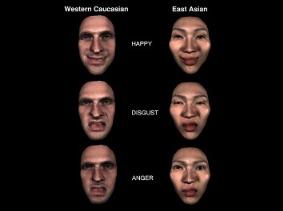Facial expressions of emotion are not universal
“Our data highlights the powerful influence of culture on shaping basic behaviours once considered biologically hardwired.” The system used by scientists studying facial expressions – the Facial Action Coding System (FACS) – identifies specific muscles used in generating facial expressions. The activation of different muscles combine to make a facial expression.
The Glasgow team – Rachael Jack, Oliver Garrod, Hui Yu and Philippe Schyns – used a unique computer platform developed at the University whereby they scanned and recorded people who are able to move all of the 40-plus muscles coded within FACS individually. This allowed them to generate any expression on the computer and control the intensity and speed. In the study the random expression were reverse correlated – meaning the subjects themselves gave meaning to the expression based on their own assumptions.
A result of the study is that the researchers were able to compile a database of valid East Asian facial expressions, since up until now, the gold standard in emotion research comprised facial expressions only recognised by Western Caucasian culture due to the belief that facial expressions of emotions are universal.
The research was funded by the Economic and Social Research Council, the Medical Research Council and the British Academy and published in the Proceedings of the National Academy of Sciences.

